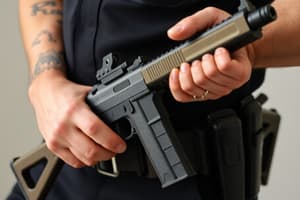Podcast
Questions and Answers
What is the initial action to take when a subject grabs your holstered handgun?
What is the initial action to take when a subject grabs your holstered handgun?
- Ask the subject to release the weapon.
- Deliver strikes to the subject's head immediately.
- Adjust your stance to maintain balance. (correct)
- Withdraw the handgun quickly from the holster.
Which technique should be used when a subject grabs the barrel of a drawn handgun?
Which technique should be used when a subject grabs the barrel of a drawn handgun?
- The overhead shield technique.
- The cradle handgun retention technique. (correct)
- The low carry technique.
- The aggressive disengagement technique.
What is an important verbal action to take during both handgun retention techniques?
What is an important verbal action to take during both handgun retention techniques?
- Negotiate with the subject.
- Remain silent to avoid distraction.
- Use loud, clear verbal commands. (correct)
- Speak softly to avoid escalating the situation.
When executing the cradle handgun retention technique, what is the first step?
When executing the cradle handgun retention technique, what is the first step?
What should be done after leveraging the gun barrel upward in the cradle technique?
What should be done after leveraging the gun barrel upward in the cradle technique?
What is the primary goal of weapon retention techniques?
What is the primary goal of weapon retention techniques?
Which technique is specifically designed for intermediate weapons worn on the belt?
Which technique is specifically designed for intermediate weapons worn on the belt?
What must be maintained to effectively defend against a subject grabbing an intermediate weapon?
What must be maintained to effectively defend against a subject grabbing an intermediate weapon?
What is the first step in the drawn baton retention technique?
What is the first step in the drawn baton retention technique?
When executing weapon retention techniques, what should be used throughout the application?
When executing weapon retention techniques, what should be used throughout the application?
In holstered handgun retention, when should the technique be used?
In holstered handgun retention, when should the technique be used?
What should be done after securing the weapon during holstered intermediate weapon retention?
What should be done after securing the weapon during holstered intermediate weapon retention?
What action is involved in drawn baton retention when a suspect grabs the baton?
What action is involved in drawn baton retention when a suspect grabs the baton?
Flashcards
Holstered handgun retention
Holstered handgun retention
Technique for defending a holstered handgun when grabbed by a subject, involving maintaining balance, applying downward pressure, striking to break grip, and following up with appropriate actions.
Reactionary gap
Reactionary gap
Maintaining a safe space between oneself and a subject to prevent a grab.
Drawn handgun retention (cradle technique)
Drawn handgun retention (cradle technique)
Defense technique used when a subject grabs a drawn handgun's barrel, involving widening stance, moving the handgun closer to the chest, wrapping arms, leveraging the barrel upward, creating distance, and following up with appropriate actions.
Verbal commands
Verbal commands
Signup and view all the flashcards
Maintaining balance
Maintaining balance
Signup and view all the flashcards
Weapon Retention
Weapon Retention
Signup and view all the flashcards
Reactionary Gap
Reactionary Gap
Signup and view all the flashcards
Holstered Intermediate Weapon Retention
Holstered Intermediate Weapon Retention
Signup and view all the flashcards
Drawn Baton Retention
Drawn Baton Retention
Signup and view all the flashcards
Holstered Handgun Retention
Holstered Handgun Retention
Signup and view all the flashcards
One Handed Baton Retention
One Handed Baton Retention
Signup and view all the flashcards
Two Handed Baton Retention
Two Handed Baton Retention
Signup and view all the flashcards
Verbal Commands
Verbal Commands
Signup and view all the flashcards
Study Notes
Weapon Retention Techniques
- Goal: Demonstrate safe and effective weapon retention methods during confrontations.
- Principle: Controlling weapons to prevent suspect seizure is crucial, especially in close-quarters combat. Maintaining a reactionary gap is vital.
- Methods: Holstered intermediate weapon retention, drawn baton retention, holstered handgun retention, and drawn handgun retention are covered techniques.
Holstered Intermediate Weapon Retention
- Technique Applicability: Applicable to all intermediate weapons worn on the belt (batons, chemical agents, CEWs).
- Defense Principle: Maintain reactionary gap; utilize loud, clear verbal commands throughout application.
- Steps:
- Adjust stance for balance.
- Secure the weapon by applying downward pressure.
- Deliver strikes to target areas while rotating the body to break the subject's grip.
- Follow up with appropriate actions. (Refer to Figure 4-80)
Drawn Baton Retention
- Technique Applicability: Effective for one-handed and two-handed grabs.
- Defense Principle: Loud, clear verbal commands are essential during application.
- Steps:
- Adjust stance for balance.
- Rotate the baton's long end upward from left to right to release subject's grip.
- Pull the baton back and away.
- Follow up with appropriate actions. (Refer to Figure 4-81)
Holstered Handgun Retention
- Technique Applicability: Use when the holster is firmly affixed to the belt.
- Defense Principle: Maintain reactionary gap; loud, clear verbal commands are crucial.
- Steps:
- Adjust stance for balance.
- Secure the weapon by applying downward pressure.
- Deliver appropriate strikes to target areas to break the subject's grip while rotating your body.
- Follow up with appropriate actions. (Refer to Figure 4-82)
Drawn Handgun Retention
- Technique Applicability: Use when the subject grabs the drawn handgun's barrel.
- Defense Principle: The cradle technique emphasizes leverage difference; loud, clear commands are essential.
- Steps:
- Widen stance and lower center of gravity.
- Move forward, bringing handgun closer to chest.
- Wrap non-weapon arm around the handgun and subject's hand, securing tightly to chest.
- Lever gun upward to detach from subject's grasp.
- Create distance by stepping back while pulling the cradled handgun downward.
- Follow up with appropriate actions. (Refer to Figure 4-83)
Studying That Suits You
Use AI to generate personalized quizzes and flashcards to suit your learning preferences.




